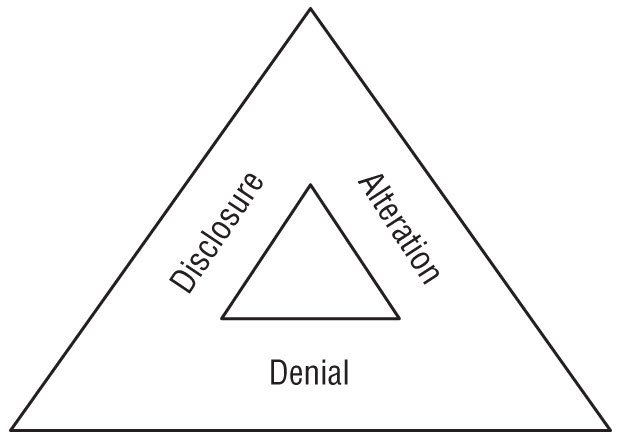
In the ever-evolving landscape of cybersecurity, frameworks and models play a crucial role in understanding and mitigating threats. One such model that complements the well-known CIA triad is the DAD triad, focusing on the key threats to cybersecurity: Disclosure, Alteration, and Denial. This article delves into the intricacies of the DAD triad, its significance, and how it can be a valuable tool for cybersecurity planning and risk analysis.
The DAD Triad Unveiled
The DAD triad, depicted below, encompasses three fundamental threats to cybersecurity, each aligning with one of the primary goals of cybersecurity: confidentiality, integrity, and availability.

1. Disclosure: Preserving Confidentiality
Disclosure involves the exposure of sensitive information to unauthorized individuals, commonly referred to as data loss. This threat directly violates the principle of confidentiality. Whether intentional or accidental, disclosure poses a risk to organizations. Attackers gaining access to sensitive information and removing it from an organization, known as data exfiltration, is a prime example of disclosure. Accidental disclosure may occur due to misconfigured access controls or the loss of a device containing sensitive data.
2. Alteration: Upholding Integrity
Alteration refers to the unauthorized modification of information and is a breach of the integrity principle. Attackers may seek financial gain by manipulating records within a system, such as adding fraudulent transactions to a financial account. Alteration can also stem from natural events, like a power surge causing a “bit flip” that alters stored data. Accidental alteration is a possibility, arising from unintentional user actions, such as typos or other unintended modifications.
3. Denial: Ensuring Availability
Denial involves the disruption of authorized user access to information, violating the principle of availability. Whether intentional, like a distributed denial-of-service (DDoS) attack against a website, or unintentional, such as a critical server failure or a natural disaster impacting communication circuits, denial events impede legitimate access to information.
Utilizing the DAD Triad in Risk Analysis
The CIA and DAD triads serve as invaluable tools for cybersecurity planning and risk analysis. When tasked with assessing security controls or identifying threats to an organization, these triads offer guidance. For instance, in analyzing threats to a website, the DAD triad can be applied:
- Disclosure: Is sensitive information on the website that, if disclosed to unauthorized individuals, could harm the organization?
- Alteration: Would unauthorized modification of information on the website cause financial, reputational, or operational damage?
- Denial: Does the website perform mission-critical activities, and would a disruption significantly damage the business?
By posing these questions, organizations can conduct a thorough risk assessment, identifying vulnerabilities and formulating strategies to enhance cybersecurity defenses.
Conclusion
The DAD triad enriches the cybersecurity landscape by providing a focused lens on the three fundamental threats of disclosure, alteration, and denial. By incorporating this model alongside the CIA triad, organizations can conduct more comprehensive risk analyses, ensuring a robust cybersecurity posture.
As cyber threats continue to evolve, understanding and leveraging frameworks like the DAD triad are vital for safeguarding sensitive information and maintaining the integrity and availability of critical systems.
You may also like:- How To Fix the Crowdstrike/BSOD Issue in Microsoft Windows
- MICROSOFT is Down Worldwide – Read Full Story
- Windows Showing Blue Screen Of Death Error? Here’s How You Can Fix It
- A Guide to SQL Operations: Selecting, Inserting, Updating, Deleting, Grouping, Ordering, Joining, and Using UNION
- Top 10 Most Common Software Vulnerabilities
- Essential Log Types for Effective SIEM Deployment
- How to Fix the VMware Workstation Error: “Unable to open kernel device ‘.\VMCIDev\VMX'”
- Top 3 Process Monitoring Tools for Malware Analysis
- CVE-2024-6387 – Critical OpenSSH Unauthenticated RCE Flaw ‘regreSSHion’ Exposes Millions of Linux Systems
- 22 Most Widely Used Testing Tools








